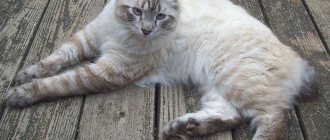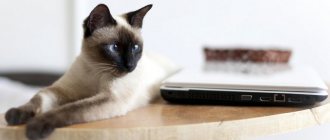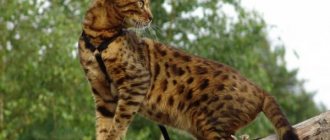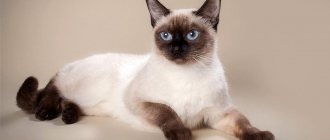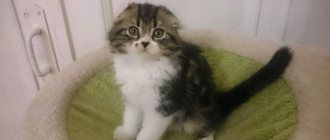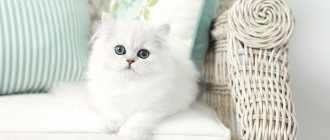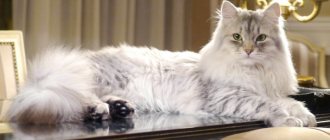The British Longhair cat or Highlander has a wide muzzle and a smile on it, reminiscent of the Cheshire cat from Alice in Wonderland. The face of a teddy bear, thick fur and a gentle character are three secrets of popularity among cat lovers. But, it is not so simple and the origins of the breed stretch back to the Roman conquerors of Britain, to old cat breeds. Once a hunter and protector of barns, the British cat is now a family favorite, preferring the comfort of the hearth and playing with a toy mouse.
History of the British Longhair breed
The appearance of the British Longhair can be considered an accident, since it was a by-product of crossing the British Shorthair with a Persian cat . The purpose of such matings was to obtain new colors and improve the type of breed. However, in addition to the desired characteristics, the British inherited the recessive gene for long hair (LH).
British Shorthairs have plush fur.
It does not appear immediately and not always, imperceptibly passed on from generation to generation. Within the existing known pedigree there may not be an ancestor with this trait, and according to official documents the parents may be purebred British with short plush hair. With a certain gene combination, if both parents have this gene in their chromosome set, fluffy, long-haired kittens are born in the litter.
In one litter, a British shorthair with the DS gene gave birth to kittens with different hair lengths
For a long time, such individuals did not attract attention; moreover, they were carefully rejected from breeding work. These rules are especially strict in the UK. There, and to this day, only those animals are considered purebred British in whose pedigree there have been no long-haired ancestors for at least the last five generations. Local phenological organizations monitor this very strictly.
Currently, the situation has changed, and individuals with long hair are purposefully bred. In 2001, the Highlander breed was registered by TICA (International Cat Association) as an independent experimental breed, and in 2004 the first breed standard was developed. In January 2009, British Longhairs received official recognition under the WCF (World Cat Federation) system and can receive championship titles at shows.
Britons with long hair began to be purposefully bred
The first experiments on crossing short-haired British and Persians were carried out at the beginning of the 20th century (1914 and 1918). The First World War, which interfered with breeding work, greatly slowed down this process. A huge part of the population was lost during the Second World War.
The first experiments on crossing the British with the Persians were carried out at the beginning of the last century
Origin
The ancestor of this breed is considered to be the “mountain lynx”.
The cat breed was bred in 2004. English breeders made a unanimous decision to introduce to the world a new breed, similar in appearance to a wild lynx. The “mountain lynx” was taken as the basis. It does not belong to wild cats, and does not contain wild genes in its own genus. The crossing was pure, without the use of hybrids. To breed cats with the desired appearance, breeders selected pets with the required coat color. The experiment was a success and the result was a small domestic lynx, but completely harmless, gentle and friendly. The new breed is nicknamed Highland Lynx, which translates to “mountain lynx.” Received official recognition in 2005.
Behavior and character
The Highlander cat is a wonderful choice of pet. They have a friendly and calm disposition. In the presence of strangers, the pet does not hide, but enjoys contacting them. Cats do not prefer to make sounds; they tend to show their own opinions through gestures and touches. They get along easily with kids and other pets. Due to its calm nature, conflicts are excluded. But you need to carefully consider the situation, if there are rodents and birds in the house, the instincts are not canceled. To eliminate the possibility of tragedy, owners need to closely monitor their pets when they are in the same room.
Health and illness
Tartar is one of the few pathologies to which these pets are susceptible.
Highlander cats are a strong and resilient breed, but are prone to certain diseases. Heart disease can be inherited genetically. Like other breeds with a short muzzle, the animals are predisposed to the formation of tartar. It is necessary to systematically examine the cat’s oral cavity and monitor the cleanliness of the teeth. Representatives of the breed also have problems with obesity and suffer from allergic reactions. It is necessary to vaccinate cats according to the vaccination schedule.
Nutritional Features
The cat breed is large in size and does not complain about its appetite. In nutrition, it is necessary to adhere to generally accepted standards, and not give students the opportunity to overeat. Excess food threatens obesity, and as a result, leads to many problems with well-being. When selecting dry food, preference should be given to premium products, in addition. It is possible to dilute the diet with pates and canned food of similar labeling. With a natural diet, you need to give cats a complex of vitamins. The basis should be meat and meat by-products - rabbit, chicken, beef, pork, chicken liver, heart, ventricles. It is recommended to boil the products before use; if served raw, you must first scald them with boiling water. In addition to food, animals need fresh drinking water.
Description of the British Longhair cat breed
The external breed characteristics of long-haired British dogs are very close in standards to their short-haired counterparts. The main difference is the length of the coat.
Appearance
The Highlander's physique is massive, powerful, slightly squat, with massive hips and shoulders, a wide chest, a strong, muscular short neck and a straight back. Sexual dimorphism is very pronounced, females are noticeably smaller than males.
The body type of the British Longhair is dense and stocky.
Standard breed conformation characteristics are described as follows:
- a round and wide head with large, developed cheeks and convex, pronounced whisker pads, a short muzzle with wide cheekbones and a round, strong chin;
- the nose is short and straight with a barely noticeable depression (without a stop);
- small ears are set quite low, rounded at the ends;
- round, large, wide-open eyes are set deep, the outer corners are slightly lowered, the color of the eyes is any (blue, yellow, orange, emerald, etc.), in harmony with the color of the coat;
- the limbs are short, thick and muscular with rounded, wide paw pads;
- the tail is thick and short, the tip is rounded;
- male weight is 5.5–7 kg, female — 4–5 kg.
The British have short and thick limbs
A stop in cats is a pronounced depression in the profile line, when there is a sharp, almost 90-degree transition from the line of the forehead to the back of the nose.
The long-haired British cat has a very cute face
The coat of these British cats is dense, elastic and not adjacent to the body, has an average length and a well-developed thick, abundant undercoat. The coat is plush to the touch and a little rough, but softer than the British Shorthair variety. It is desirable to have panties on the hind legs and a fluffy collar on the neck, the tail should also be heavily pubescent.
The British Longhair can have any eye color.
The standard allows a variety of colors:
- plain (white, red, chocolate, red, lilac, blue, cream, black, etc.);
- tortoiseshell;
- tabby (marbled, spotted, brindle or tabby);
- color point (Siamese);
- smoky;
- bicolor (two-color), etc.
The standard allows a variety of colors of British dogs
The most common color of the British longhair cat is blue.
Photo gallery: color of longhaired British cats
British Longhair cats come in solid colors
British Longhairs Can Have Green Eyes
Bicolor coloring is also allowed as standard
Striped colors are less common
The most common color among British longhairs is blue.
Tortoiseshell color is quite rare
Longhaired British cats should have a fluffy collar on their necks and puffy pants on their hind legs.
Longhaired British dogs even come in Siamese colors
Calico cats are considered rare
Long-haired British harlequins look very unusual
Video: British Longhair at a cat show
Character
British cats have a calm and balanced disposition. It is extremely difficult to scare or bring such an animal out of its state of Spartan calm. But if you manage to evoke emotions in your pet, then he can really get offended and sit in a secluded corner for a long time. Highlanders are independent, do not need the constant company of their owners, and often prefer to lie on the sofa in splendid isolation. Left alone, they do not get bored, but calmly wait for their owners to return. You can leave them at home all day and not have to worry about anything. Nothing extraordinary will definitely happen, the furniture and furnishings will remain intact, and the other animals living in the house will be alive and healthy.
Longhaired British cats have a phlegmatic, calm character.
However, they cannot be called unsociable, because they easily find a common language with other pets, be it a large dog, a guinea pig or even a hamster. Thanks to their sedateness and inherent self-esteem, these long-haired cats steadfastly endure children's pranks and never show aggression towards anyone. They treat small children very tolerantly, although they do not like excessive squeezing, carrying in their arms and increased attention to their person. If they are really bothered, they will calmly and with dignity leave the room. Like true Englishmen, they are intellectuals, smart, reserved, well-mannered and unobtrusive.
Long-haired British cat prefers to lounge on the sofa
The kids are playful, restless and inquisitive, like all kittens. They get used to family members and a new home without any problems. The order established in the house is quickly understood and all conditions are fulfilled unquestioningly. They get used to the tray easily and never mess up. But their upbringing needs to be done from an early age. As kittens grow older, they calm down, become more and more phlegmatic and would much rather sleep in their basket than chase a ball. Cats of this breed are distinguished by enviable patience; they never meow or beg for food, even if they are very hungry.
Longhaired British kittens play a lot
British longhair cats are completely devoid of hunting instinct, so you should not expect them to help in the fight against rodents.
Highlanders boast a very stable psyche and immunity to stressful situations. They calmly endure trips to the veterinary clinic, transportation, new places and a large number of strangers at exhibitions.
British Longhairs easily tolerate travel and cat shows.
From personal experience. When visiting cat shows, you involuntarily pay attention to British cats. The length of the fur does not matter here. Both short-haired and long-haired Britons are equally phlegmatic. Only they can afford to sleep peacefully on a pillow, freely stretching out to their full height, when there is noise and a crowd of people walking around. A sleeping cat won’t even move his ears, although children are milling around him and screaming. When experts and judges examine them, they endure this procedure, which is unpleasant for most cats, with complete equanimity. In this sense they are ideal.
Appearance
The features of this breed are the following.
- Ears that stick out upward (the tips are bent inward). In small kittens the curl is pronounced.
- Strong body with strong muscles.
- Round head with expressive, slanting eyes. Their colors are varied: from greenish-golden to blue.
- Limbs of medium length. The hind legs are longer than the front ones.
- Short, thick tail (up to 3 cm).
- Large paws with pronounced knuckles. This breed is characterized by polydactyly (the number of fingers exceeds the norm).
The weight of Highlanders varies from 5 to 9 kg. Naturally, males are larger than females. There are short-haired and long-haired cats. The former have shiny fur that fits tightly to the body. Those with long hair have a movable long tail. The color of the Highlanders is unusual and “predatory”. The following varieties can be distinguished.
- Classic marble.
- Spotted. The pattern is scattered throughout the body and has different sizes and shapes.
- Tiger (mackerel). It is characterized by the presence of dark stripes on the sides.
The patterns on the pet's face and forehead are a typical tabby. The legs and short tail are covered with dark stripes. Note that according to the TICA standard, the color of a cat is determined by the color of the undercoat. For example, if an animal’s fur visually looks black with a silver tint, and the undercoat is dark brown, then the pet’s color is still considered brown.
Purchasing a British Longhair kitten
Longhaired British cats are not uncommon, so purchasing a kitten now will not be difficult. There are a large number of nurseries and breeders who professionally breed these cats. You can buy a kitten through an advertisement from a private person.
Buying kittens of the longhaired British breed is not difficult.
Criterias of choice
When purchasing, you must first decide what kind of pet you need. Breeders divide kittens into classes:
- show - ideally meet all breed standards, are intended for exhibition activities and breeding, the price for such kittens is the highest and strongly depends on the characteristics of color, gender and specific characteristics of the pedigree;
- breed - have minor flaws in appearance, but are allowed to participate in exhibitions and are used in breeding, they are cheaper;
- pet - in appearance there are serious deviations from breed standards or even defects, which excludes their participation in breeding work, such animals are subject to mandatory castration or sterilization in order to avoid unwanted matings, their cost is low.
Only an experienced breeder and expert can identify a long-haired show-class British kitten.
You can buy a Highlander kitten without documents; such an animal will cost quite a bit. But no one can guarantee that this is a Briton at all, and not just a fluffy mongrel kitten. Only a specialist can accurately determine the class of a small pet, but severe deficiencies (bad bite, high-set ears, curled tail, etc.) can be seen immediately.
British breed kittens must have:
- the head is rounded on a short thick neck, the forehead is wide and round;
- plump, prominent cheeks;
- small round ears;
- the nose is medium without a visible transition in the forehead area;
- the eyes are widely spaced (the color is usually not yet determined);
- the limbs are short, the paws are thick and rounded;
- The coat is elongated, fluffy with a densely packed undercoat.
The small longhaired Briton should be round, heavy and powerful
The baby should give the impression of being round, heavy, powerful and knitted. To confirm the purebred, the breeder is obliged to provide the relevant documents: birth certificate, pedigree, veterinary passport with notes on preventive vaccinations, etc.
It is recommended to look at the entire litter, the kitten's parents, or at least one of them, since the breeder's words should not always be trusted. Sometimes long-haired cubs are born to short-haired British cats. It is impossible to visually distinguish such babies.
By buying a kitten without documents from your own hands, you can buy an ordinary outbred pet
Whatever class the kitten is, the main thing is that it is healthy. You should pay attention to the following signs:
- the baby should be active, not intimidated and lethargic, but not aggressive;
- looks like a teddy bear with shiny, thick and dense fur without matted or stuck together areas;
- the eyes are clean and clear, without any discharge;
- skin without redness, peeling or other damage;
- The ears are clean, without dark plaque.
At what age is it better to adopt a kitten?
It is recommended to purchase kittens after 3–4 months. At this age, they already eat on their own, are accustomed to the tray and scratching post, and also have all the vaccinations appropriate for their age.
It is recommended to purchase kittens after 3–4 months
How to choose a kitten
- As the breed continues to gain popularity, buyers will encounter unscrupulous sellers selling problem animals. In order to purchase a kitten, it is better to go to breed exhibitions where professionals gather.
- Fans of more playful pets are advised to opt for a male kitten. Long-haired “British girls” are calmer and more phlegmatic than males.
- Look for a nursery registered in the WCF felinological system - such institutions value their reputation and do not breed animals without pedigrees. In addition, the websites of most of them contain photos and documents of the producers, from which you can get a relative idea of the appearance of future litters.
- British Longhair kittens are sold starting from the age of three months. If the breeder offers to give the baby away earlier, there is a catch.
- In three-month-old kittens, the exterior potential is practically not visible, so for exhibitions it is better to take older individuals (4-6 months), whose iris color has been determined and the first moult has passed.
- Assess the living conditions of the cat and its offspring. The nursery should be clean and warm, and the animals should look healthy and well-groomed.
- Browse advertisements for the sale of child support children. They are given by cat owners who receive a kitten as payment for mating their ward with a cat from the nursery. Buying such kittens is quite acceptable, especially since the maintenance animal is given away first, and is usually the cutest kitten in the litter. The main thing is to check the purity of the parents’ pedigrees.
Keeping a British Longhair cat
There are no special tricks in keeping Highlanders. Caring for them is not difficult, but some nuances must be taken into account.
Nutrition
The diet of British longhairs can be based on ready-made dry food or natural products. The type of food is selected depending on the sex and age of the animal, as well as its character, health status and personal tastes.
Feeding a Highlander regular human food from a common table is strictly prohibited.
Quantity and composition of food
British cats are prone to overeating and obesity, so the amount of food must be accurately measured. You cannot overfeed them. The optimal intake for this breed is 70 kcal per 1 kg of live weight.
British Longhairs are prone to overeating and obesity
Natural nutrition should consist of the following products:
- lean types of meat (veal, turkey, beef, rabbit, etc.);
- boiled meat by-products (kidneys, liver, lungs, heart, etc.);
- sea fish, boiled and boneless;
- cereal porridges (buckwheat, barley, rolled oats, etc.);
- quail eggs;
- low-fat fermented milk products (cottage cheese, kefir);
- sprouted grains (oats, wheat).
It is better to feed the meat raw, since all cats remain carnivores. Before this, it is thoroughly frozen for 12–24 hours, then poured with boiling water and waited until it completely thaws. Meat is given to pets completely defrosted and at room temperature.
The British Longhair cat's diet must include raw meat.
Excluded from the diet:
- fatty meats (pork, lamb);
- tubular bones;
- potatoes in any form, since they are practically not digestible;
- sweets;
- legumes;
- salted, peppered, fried, smoked, spicy and spicy food.
When feeding with ready-made factory formulas, preference should be given to high-quality premium and super-premium food, developed specifically for long-haired cats and containing all the vitamins and minerals necessary for the normal functioning of the animal. There should always be access to clean drinking water and it should be changed every day.
British Longhairs should be fed premium dry food
It is highly recommended not to mix different types of food. This can lead to problems with the liver and stomach.
How many times a day should you feed your pet?
Small kittens are fed frequently, at least 5-6 times a day. Gradually the number of feedings is reduced and by 12 months they switch to two meals a day.
The role of a balanced diet in cat health
For animals with long coats, a balanced diet is especially important, since the appearance and condition of the coat will directly depend on this.
With natural nutrition, it is necessary to add vitamin and mineral complexes, and ready-made specialized feeds already contain all the necessary components
It should be possible to consume special cat grass for any type of diet.
Many cats love to eat grass
Appearance care
Taking care of the appearance of Highlanders is not as difficult as it might seem at first glance. But there are several important points that must be taken into account.
Brushing and bathing
Purebred representatives of the longhaired British breed have hair that is not prone to matting, unlike Persian cats. The coat is not so long and the undercoat is not so abundant. To keep the coat in good condition, it is enough to comb your pet 2-3 times a week with a soft rubber brush or a special mitten to remove dead hairs. During the spring and autumn molting period, this procedure is carried out daily. During the hot season, long-haired British dogs can be cut to make them more comfortable.
To comb out dead hairs, it is better to use a soft rubber brush.
When a cat sheds heavily, it is necessary to give it special medications to help dissolve the hairballs in the stomach.
Highlanders are bathed no more than 2-3 times a year, unless there is an urgent need for it. They do not like water very much, so they need to be accustomed to this procedure as early as possible. When bathing, be sure to use special pet shampoos and conditioners for long-haired breeds.
Longhaired British dogs can be cut
Ear care
The small ears of longhaired Britons do not require special attention and care. They are examined 2-3 times a month, and if necessary, any dirt that appears is removed using a cotton pad soaked in chlorhexidine or a special solution for caring for the ears of cats and dogs.
Long-haired British ears are cleaned 2-3 times a month using a special solution.
Eye care
The pet's eyes are examined daily and, if necessary, wiped with special wet wipes for eye care, cotton pads with pharmaceutical products, or simply with warm boiled water.
The cat's eyes are wiped with special wet wipes.
From personal experience. When we still had our first Siamese cat, and that was quite a long time ago, she was absolutely healthy until she was 3-4 years old. Then, somehow, unexpectedly, a thorn appeared on one eye. At that time, pets were treated much more simply and for a long time they did not pay much attention to this defect; besides, it did not interfere with the life of the cat. But at one point the spot became very noticeable, and the pet was taken to the veterinary clinic. They treated her for a very long time, constantly dropping something and pouring it into her eye. The veterinarian even then said that it was necessary to immediately show the animal to him and begin treatment as quickly as possible.
Nail care
To independently care for its claws, your pet must be provided with a scratching post. Since Britons are a fairly large breed, this device must be well secured and of a suitable size.
Shorten the claws once every 2–3 weeks using special scissors (nail clippers)
Dental care
To avoid possible oral diseases, your cat should brush its teeth about once a week with a leave-in pet toothpaste.
It is convenient to clean your cat's teeth with special brushes.
Toilet
There are no special requirements for choosing a tray and filler for long-haired British cats. The only thing you need to consider is the size of the animal. It is necessary that the pet can freely turn around in its potty and not accidentally turn it over. The filler is chosen depending on the personal tastes of the owners.
The litter box for a British cat should be spacious enough
If a kitten is purchased from a nursery or from a reputable breeder, then it is usually already litter box trained. In this case, they try to use the same filler that the pet is already accustomed to.
Walks
British Longhair cats are homebody cats. They are quite happy with being in a confined space of several rooms and there is absolutely no need to walk them outside. They feel great without walking in the fresh air.
Not all longhaired British cats like to go for walks
Experience shows that not all Britons like to stay at home. Some individuals prefer to spend all their free time outside. Our neighbors have a very purebred British cat of a gray-blue color, although short-haired. At the slightest opportunity, he strives to sneak out of the house to freedom. He has taken control of all the neighboring areas and regularly drives out aliens from there. And since the cat is very large (no less than 7-8 kg), he always wins in a fight.
Character
Many owners claim that the Highlander's character is more like a dog's than a cat's. They are distinguished by good nature and incredible devotion.
These cats get along well with other animals. They get along equally well with other cats, dogs and even ferrets and small rodents.
Highlanders are great with children and enjoy frolicking and running around with them. By nature, these are very active and playful cats, but not so much that they climb curtains and tear wallpaper.
Disadvantages of the British Longhair breed
Highlanders are distinguished by excellent health and good immunity. With proper care, they practically do not get sick and can live for more than 20 years.
Tendency to diseases
In general, Highlanders are considered healthy animals, not burdened with genetic disorders . However, they experience the following health problems:
- Hypertrophic cardiomyopathy is an inherited heart disease (thickening of the ventricular wall). In the early stages it manifests itself as shortness of breath and fatigue. Then there may be signs of thromboembolism (blockage of blood vessels with blood clots). More often the femoral arteries are affected, paralysis of the hind limbs occurs, the cat cannot stand up and screams in pain. Possible pulmonary edema and death. Diagnosed only by ultrasound examination of the heart. The disease is incurable, such animals are excluded from breeding.
- Formation of tartar. A problem common to all short-faced cats. For preventive purposes, you should brush your pet’s teeth with a soft curved brush and special toothpaste.
- Obesity. Characteristic of sedentary individuals. It is necessary to carefully control the diet and stimulate physical activity.
- Allergy. The pet itches, his eyes become watery and swollen. The allergen is identified and eliminated, and antihistamines are given (prescribed by a doctor) to relieve symptoms.
- Colds. Drafts must be avoided.
It is necessary to periodically deworm the animal, show it to the veterinarian at least once a year, and do not forget about timely vaccination.
A British Longhair cat should be taken to the veterinarian at least once a year.
Defects in appearance
The following are considered serious appearance flaws:
- stop on the muzzle;
- thin and insufficiently full cheeks;
- wool that is too soft and too long;
- pinch - very pronounced whisker pads;
- flat forehead;
- high set ears;
- narrowed “fox” muzzle.
A British cat should have a normal profile without a pronounced transition from the forehead to the nose
They are not allowed to participate in exhibitions and are excluded from breeding if the following defects are present:
- skeletal deformities, cryptorchidism;
- any abnormalities of the jaws (overshot, undershot, insufficient number of teeth, etc.);
- blindness;
- strabismus;
- deafness;
- eyelid abnormalities.
Breeding British Longhair cats
The breed of British Longhair cats has not yet fully developed, so breeding presents some difficulties. Crossbreeding is allowed only with representatives of the same breed. Some felinologists practice mating with British shorthairs who have long-haired ancestors in their pedigree. Long-haired individuals born from such matings are registered with the marks BLH or BRL (TICA, WCF).
Finding a mate for a British Longhair cat is not difficult at all.
Criteria for choosing a partner
To conduct high-quality breeding work, it is necessary to carefully select a partner for mating . It must meet the following requirements:
- strict compliance with all breed characteristics;
- availability of the necessary package of documents (club card, pedigree, veterinary passport, breeding permit, etc.);
- absence of defects in appearance and health problems;
- vaccination and deworming were carried out (at least 2-3 weeks before the intended mating).
Experienced cat breeders recommend looking at your partner’s previous offspring.
To avoid problems with incompatibility of blood types (A and B), before mating, you need to conduct a DNA test to determine the type (if it has not been previously determined).
At what age should you give your pet for the first mating?
Highlanders reach sexual maturity after 6–9 months, but mating is recommended no earlier than a year . If the female is bred too early, the birth may be difficult, and the offspring will be weak or non-viable. Males sometimes lose strength before they are two years old.
How often can a cat give birth?
Estrus in long-haired British cats occurs less frequently than in other purebred cats. Therefore, it is believed that it is enough for Highlanders to have offspring once a year (sometimes twice).
Long-haired British women are recommended to give birth no more than 1-2 times a year
British women with long hair have up to 6 kittens in their litter.
Castration and sterilization of British Longhairs
It is necessary to exclude from breeding all animals that do not meet the conformation standards of the breed or have health problems or genetic pathologies. These individuals are subject to mandatory castration or sterilization to avoid unwanted matings.
At what age is it recommended to do it?
British Longhair cats are spayed or neutered at approximately 8–10 months of age. It is very advisable to have time to carry out the operation before the first mating, while the animal’s behavioral habits have not yet fully formed.
If surgery is done too early, your pet may experience developmental delays.
Caring for your pet after surgery
Postoperative care after castration or sterilization is as follows:
- provide the operated animal with peace and quiet;
- limit physical activity to prevent the stitches from coming apart;
- do not feed until the pet has completely recovered from anesthesia (8–10 hours);
- Immediately put an Elizabethan collar or blanket on the cat to prevent it from licking the surgical sutures;
- if the animal is very worried and is in pain, then it is allowed to give painkillers (Pervicox, Ketofen, etc.) as prescribed by a veterinarian;
- clean the seams daily using a cotton swab and any disinfectant solution (hydrogen peroxide, chlorhexidine, etc.).
After the operation, you need to put a blanket on the cat so that he does not lick his stitches.
If any suspicious or unusual situations arise (sutures get wet and fester, body temperature rises, etc.), you should definitely contact a veterinarian to clarify the situation and receive qualified help.
Owner reviews
There are quite a lot of reviews about the British Longhair cat. Here are some of them:
Each animal has a different character. Much depends on upbringing.
Table: pros and cons of the British Longhair breed
| pros | Minuses |
|
|
